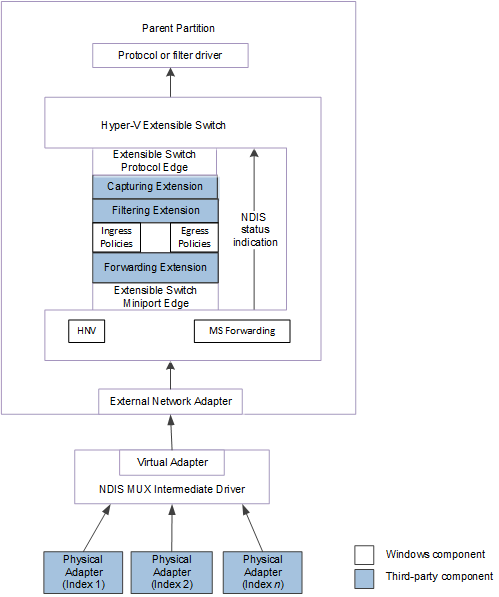Hyper-V uitbreidbaar schakeloptiepad voor NDIS-statusindicaties
In dit onderwerp wordt het besturingspad aangegeven waarlangs NDIS-statusmeldingen van een onderliggende fysieke adapter lopen. Een of meer onderliggende fysieke adapters kunnen worden gekoppeld aan de Hyper-V uitbreidbare switch externe netwerkadapter.
De uitbreidbare switch externe netwerkadapter kan bijvoorbeeld worden gebonden aan de virtuele minipoortrand van een tussenliggend NDIS multiplexer -stuurprogramma (MUX). Het MUX-tussenstuurprogramma zelf kan worden gekoppeld aan een groep van één of meerdere fysieke netwerken op de host. Deze configuratie staat bekend als een uitbreidbaar switchteam. Zie Typen configuraties van fysieke netwerkadaptersvoor meer informatie over uitbreidbare switchteams.
In deze configuratie worden de uitbreidbare switchextensies blootgesteld aan elke netwerkadapter in het uitbreidbare switchteam. Hierdoor kan de doorstuurextensie in de uitbreidbare stuurprogrammastack de configuratie en het gebruik van afzonderlijke netwerkadapters in het team beheren. De extensie kan bijvoorbeeld ondersteuning bieden voor een LBFO-oplossing (load balancing failover) via het team door uitgaande pakketten door te sturen naar afzonderlijke adapters. Een dergelijke extensie wordt een teamingprovidergenoemd. Zie Teaming Provider Extensionsvoor meer informatie over teamproviders.
Opmerking Bewerkingen van dit type kunnen alleen worden uitgevoerd door een doorstuurextensie. Zie Forwarding Extensionsvoor meer informatie over dit type stuurprogramma.
In de volgende afbeelding ziet u het uitbreidbare schakelbesturingspad voor NDIS-statusindicaties die zijn uitgegeven door een onderliggend uitbreidbaar switchteam voor NDIS 6.40 (Windows Server 2012 R2) en hoger.

In de volgende afbeelding ziet u het uitbreidbare schakelbesturingspad voor NDIS-statusindicaties die zijn uitgegeven door een onderliggend uitbreidbaar switchteam voor NDIS 6.30 (Windows Server 2012).

Opmerking In de uitbreidbare switchinterface staan NDIS-filterstuurprogramma's bekend als uitbreidbare switchuitbreidingen en wordt de stuurprogrammastack de uitbreidbare stuurprogrammastackgenoemd.
De uitbreidbare switch ondersteunt NDIS-statusindicaties van de onderliggende fysieke adapter of het uitbreidbare switchteam op de volgende manieren:
Wanneer een NDIS-statusindicatie binnenkomt bij de uitbreidbare switchinterface, wordt de indicatie in een NDIS_SWITCH_NIC_STATUS_INDICATION structuur ingekapseld. Vervolgens geeft de minipoortrand van de uitbreidbare switch een NDIS_STATUS_SWITCH_NIC_STATUS indicatie die deze structuur bevat.
Wanneer een doorstuuruitbreiding deze indicatie ontvangt, kan deze de indicatie dupliceren om de ingekapselde gegevens te wijzigen. Hierdoor kan de doorstuurextensie de aangegeven status of mogelijkheden van het onderliggende uitbreidbare switchteam wijzigen.
Een doorstuuruitbreiding die als teamprovider werkt, kan deelnemen aan de configuratie van het adapterteam voor hardware-offloads door NDIS_STATUS_SWITCH_NIC_STATUS indicaties te starten die betrekking hebben op de offloadtechnologie.
De provider kan bijvoorbeeld een NDIS_STATUS_SWITCH_NIC_STATUS indicatie initiëren met een ingekapselde NDIS_STATUS_RECEIVE_FILTER_CURRENT_CAPABILITIES indicatie om de offloadmogelijkheden voor de virtuele-machinewachtrij (VMQ) voor het adapterteam te wijzigen.
Teamproviders kunnen ook een NDIS_STATUS_SWITCH_NIC_STATUS indicatie starten om netwerkadapterconfiguraties aan te passen, anders dan de configuraties voor een uitbreidbaar switchteam.
De extensie kan bijvoorbeeld een NDIS_STATUS_SWITCH_NIC_STATUS initiëren met een ingekapselde NDIS_STATUS_SWITCH_PORT_REMOVE_VF indicatie. Deze indicatie verwijdert de binding tussen een virtuele machine (VM) netwerkadapter en een virtuele PCI Express (PCIe) functie (VF). De VF wordt weergegeven door een onderliggende fysieke netwerkadapter die ondersteuning biedt voor de single root I/O-virtualisatie (SR-IOV) interface.
Nadat deze binding is verwijderd, worden pakketten geleverd via een uitbreidbare switchpoort in plaats van rechtstreeks tussen de VM-netwerkadapter en de VF van de onderliggende SR-IOV fysieke adapter. Hierdoor kan het uitbreidbare poortbeleid worden toegepast op pakketten die worden ontvangen of verzonden via de uitbreidbare switchpoort.
Opmerking De uitbreidbare switchextensie moet dezelfde richtlijnen volgen voor het filteren van NDIS-statusindicaties die van toepassing zijn op alle NDIS-filterstuurprogramma's. Zie Statusindicaties voor filtermodulesvoor meer informatie.
Zie NDIS-statusindicaties beheren van fysieke netwerkadaptersvoor meer informatie over hoe doorstuuruitbreidingen NDIS_STATUS_SWITCH_NIC_STATUS indicaties kunnen initiëren.